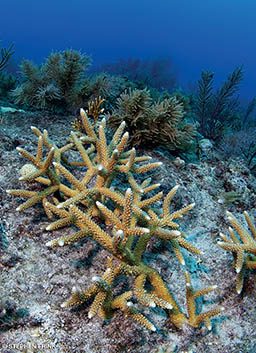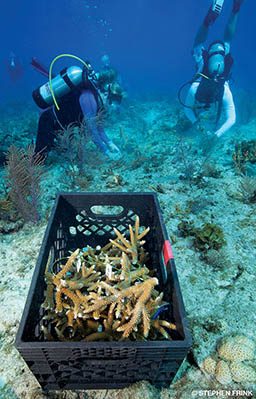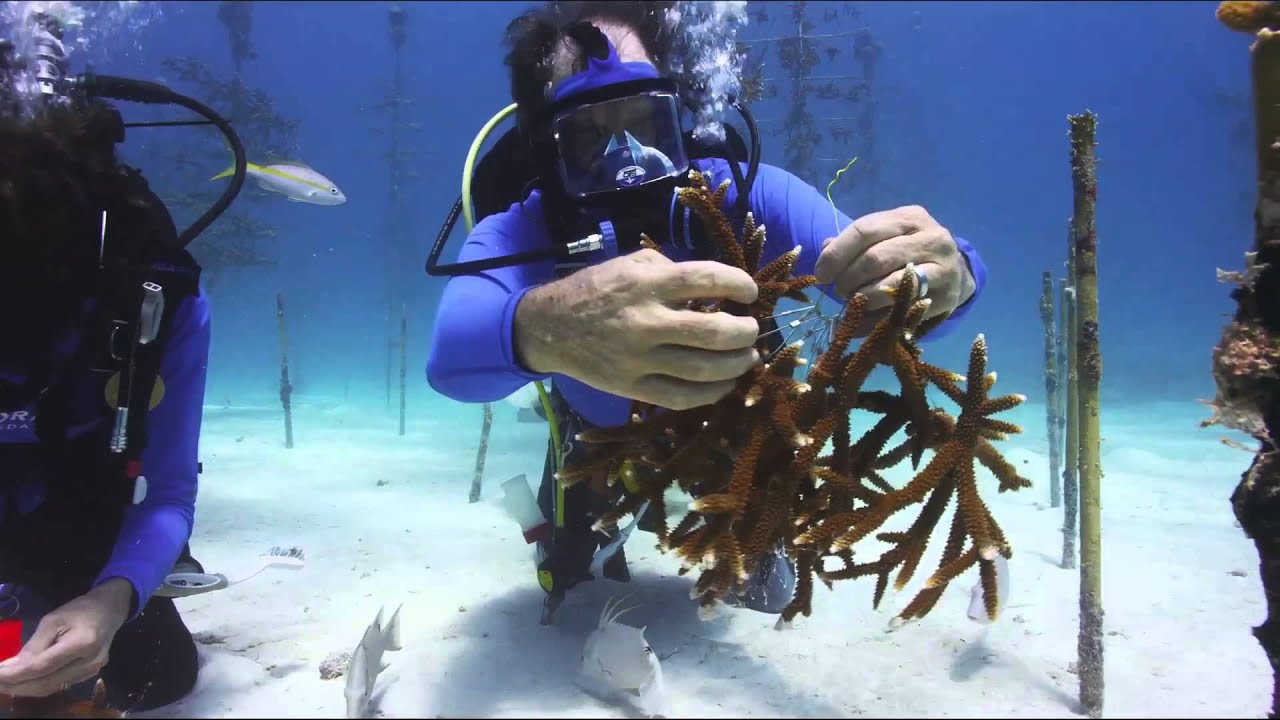For the past three decades the coral reefs of the Florida Keys have been under stress. A poisonous cocktail of high ocean temperatures, polluted runoff from coastal development, coral disease and the sudden disappearance of algae-grazing urchins (Diadema) left millions of corals stricken, many never to recover.
Two species in particular — the venerable elkhorn (Acropora palmata) and staghorn (Acropora cervicornis) varieties — felt the impact most acutely. Undisputed reef-building champions of the Caribbean for thousands of years, they had laid the foundations of the region’s most vibrant ecosystems. Since the 1970s populations of elkhorn and staghorn have declined by an estimated 92-97 percent.

Today, however, there’s a new effort in the works to rebuild these desolated reefs from the ground up with the hope that once-prosperous underwater communities could soon recapture their former glory.
The Project
In late 2016, the National Oceanic and Atmospheric Administration (NOAA) awarded a $2.1 million grant to the Florida-based Coral Restoration Foundation (CRF) to undertake one of the most ambitious coral-planting efforts in history. The project sets a target of growing more than 50,000 coral species, mostly staghorn and elkhorn, and distributing them across eight reefs along the Florida Reef Tract over three years.
For Kayla Ripple, CRF science program manager, that investment represents a major milestone for her organization and for the coral restoration field as a whole. “No one’s ever done restoration on this scale before,” Ripple said. “This is going to be the basis for our entire work for the next three years, and we’re really excited about it.”
NOAA Coral Reef Restoration Program Manager Tom Moore, whose office supports restoration of damaged areas that “need a little extra boost,” said the grant is the NOAA Restoration Center’s largest in terms of number of corals on an individual award. “Every year we’re upping the ante on what we’ve done in the past,” Moore said. “And the reality is that we have to — we don’t have any choice in the matter. In order to have restoration matter at an ecosystem level, we’ve got to continue to significantly increase the amount of restoration that’s being done every year.”

Founded in 2007 by coral-restoration pioneer Ken Nedimyer, CRF is a nonprofit organization that works to restore and study coral reefs and educate the public about the importance of the oceans. CRF has developed ingenious tools and techniques to cultivate and plant threatened corals such as staghorn and elkhorn, collectively known as branching corals or Acroporids.
One of CRF’s biggest innovations has been the development of coral nurseries off the Florida coast, where CRF staff and volunteers nurture fragments of corals into specimens large enough to transfer onto a reef in need. These floating havens, six in total, will supply all 50,000 of the corals for the three-year project. Each nursery consists of a submerged forest of PVC pipe “trees” with perpendicular branches from which up to 100 pieces of coral are suspended by fishing line.
The nursery corals are organized by species and by their genetic makeup, or genotype. Each PVC tree is also a family tree of sorts, hosting corals that are genetically identical to each other. To grow more of a particular individual, divers simply break off a small piece from the “parent coral” and hang it next to its siblings. Amazingly, some of the earliest parent corals, collected more than a decade ago as “fragments of opportunity” broken off from the reef by storms, are still going strong today. “A lot of the parent fragments have been in our nursery for 10 to 15 years now,” Ripple said. “From the initial fragments collected, you can create thousands and thousands of corals. Instead of taking coral from one reef and putting it on another, the nursery can sustain your propagation in perpetuity.”
Supercharging the Science
Perhaps even more significant than the sheer number of corals to be planted under the latest CRF project is how they plan to do it. “Basically, what we did in the past was whatever corals we had available, we would plant on the reefs,” Ripple said. “Our goal was to outplant as many different genotypes as we could.” This time the approach is different. Instead of a coral-planting free-for-all, Ripple’s team carefully selected a genetically diverse roster of corals — 50 staghorn, 50 elkhorn — based on high-resolution genome sequencing done by Steve Vollmer, Ph.D., at Northeastern University. “From there, we’re planting those genotypes across eight different reef habitats in the same design, the same way, in really large numbers,” she said.
By keeping meticulous records of where each genetic strain of coral is planted and monitoring how well they do over time, researchers will be able to look for links between a coral’s genes and its ability to survive in a particular environment. “Once we can understand what’s actually causing them to react differently, that has really broad implications for further restoration of coral reefs,” Ripple said. “So we’re hoping that this can be an example for other groups to follow.”
In fact, that’s another key requirement of the grant. To qualify for NOAA funding, CRF had to create a data-sharing plan to ensure everyone has access to the data their team gathers during the project.
“CRF is going well above and beyond here,” Moore said. “They’re actually setting up these experimental projects at all of these sites, and they’re going to be sharing that information with the research community in a way that says, ‘Come in and run your own experiments here.’ It’s a great model, and I think we’re going to get a lot out of it.”
Coral Restoration: Evolved
CRF’s ongoing approach has been one of constant experimentation, with the hope that someday the techniques its founder pioneered in 2003 could spark efforts to reinvigorate damaged reefs worldwide. “In the past, it was all trial and error,” Ripple said. “Now restoration is evolving into this massive, widespread thing across lots of different groups in lots of different countries.” CRF’s NOAA-backed, 50,000-coral effort is the latest big step in that direction.

Greg Torda, a coral researcher at the Australian Research Council (ARC) Centre of Excellence for Coral Reef Studies at James Cook University in Queensland, Australia, points out that there’s still a long way to go from a numbers standpoint. He said he recently surveyed a typical reef around a small island in Queensland for a study, and on that one single reef he found roughly 100,000 corals. “Multiply that by 3,000 reefs on the Great Barrier Reef, and you realize that it’s a drop in the ocean,” he said.
Moore said that realization is reflected in the urgency of NOAA’s restoration work. “We’re really pushing our partners to make dramatic leaps forward,” he said. “We’ve got to not just be putting 50,000 corals out a year; we’ve got to be putting a half-million corals out a year.”
Money for coral restoration is precious, Moore said, and finite — so planting 10 times more corals can’t hinge on getting 10 times more funding. That’s why the agency places such heavy emphasis on improving the per-dollar efficiency of restoration efforts, such as growing corals faster, planting them more efficiently and improving their survival rate.
Ripple said CRF hopes the data it gleans will help pinpoint specific genetic traits that make corals hardier and more resilient in various conditions. So while the restoration may be limited to CRF’s backyard, the ARC’s Torda acknowledged that the treasure trove of information the project will amass could have value that reaches far beyond the Caribbean. “I think that’s a pretty sweet dataset to tap into,” he said. “It would be very valuable indeed.”
Buying Time
One thing restoration can’t solve is persistent problems that make life hard for corals in the wild. “Restoration is only meaningful in places where you solve the problem that actually caused the mortality in the first place,” Torda said.
Corals may have something of a reputation for being fragile, but they are naturally resilient creatures. Subject them to any one source of stress — high temperatures, bad water quality, marauding crown-of-thorns starfish — and there’s a good chance they will bounce back.
But for decades, corals have been subjected to a host of slings and arrows that beat them down until they eventually succumb. “It’s like your immune system,” said Beth Dieveney, a policy analyst for NOAA’s Florida Keys National Marine Sanctuary. “The more stress you’re under, and the more impacts you’re hit by, the weaker and weaker you get.”
Some of those stressors are fixable. Dieveney said the sanctuary has developed an elaborate network of marine zones within the wider sanctuary boundaries to help protect the Keys’ coral reefs from accidental damage through popular activities like boating and fishing.
The sanctuary also issued the permits for CRF’s coral-restoration work and has spent decades seeking to educate the public and reduce threats such as land-based pollution on the region’s corals. “The idea is that the local things we can control will help shore up the coral reef for the more global impacts that are harder to address at a local level,” Dieveney said.
She’s referring to, of course, climate change and ocean acidification — two massive global problems that, left unchecked, will continue to wreak havoc on coral-reef ecosystems everywhere. And if that happens, Moore said, no amount of restoration will be enough. “Restoration is not the long-term solution here,” Moore said. “Restoration is something that helps us buy time. We can’t go out and destroy reefs because we know how to restore them. The most important thing we can do is conserve the ones we already have.”
Explore More
| © Alert Diver — Q1 2017 |

